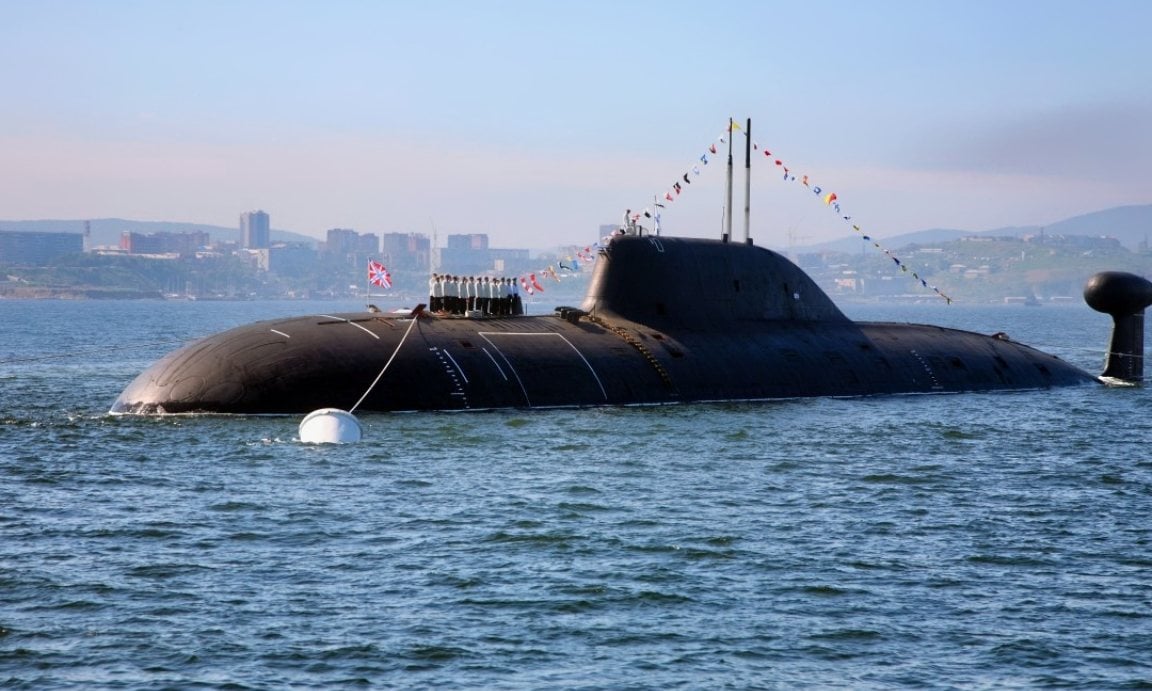Akula-Class: The Game-Changer Russian Submarine the Navy Hates
The Akula class was initially developed in response to the United States Navy's Los Angeles-class, and it has been considered a quantum leap forward in Soviet submarine technology.
In the final decade of the Cold War, the Soviet Union developed a series of fourth-generation nuclear-powered attack submarines (SSNs) – which included a number of sub-classes or flights of the Project 971 Shchuka-B. These were designated with the NATO reporting name Akula – not to be confused with the Soviet Akula-class SSBN (NATO reporting name Typhoon).
The boats first entered production in 1983. The Akula SSNs were noted for incorporating a double hull system composed of an inner pressure hull and an outer "light" hull.
That essentially allowed more freedom in the design of the exterior hull shape, which resulted in a submarine with more reserve buoyancy than western attack submarines of the era.
It also made them much quieter.
As previously reported, with the help of milling machines acquired from a Japanese firm, the Soviet shipbuilding industry designed new, higher-quality propellers that produced significantly less noise than their predecessors. The interior compartments were additionally designed to maximize sound dampening and with a slew of active noise cancellation measures.
Akula-Class: Response to the Los Angeles-Class
The Akula class was initially developed in response to the United States Navy's Los Angeles-class, and it has been considered a quantum leap forward in Soviet submarine technology. The Akula class was the follow-on to the Victor III and remained the most capable Russian attack submarine until the newer Yasen-class was developed.
A total of 20 Akula class boats were laid down, though some of them were never completed.
The first seven boats (designated in the West as the Akula I class) were the Puma, Delfin, Kashalot, Bars, Kit, Pantera and Narval. Five more (the Volk, Morzh, Leopard, Tigr and Drakon are classified as the Project 971U or Improved Akula class.
The Vepr was built to further improved Project 971M (or Akula II class). To further add to the confusion – always common with Soviet military vessels – the improved Akula I and Akula II have also been designated as Project 971U and Project 971A respectively.

Spotlight on the Akula II – the Vepr (K-157)
To date only a single Akula II was completed, the Vepr (K-157). Her keel was laid down in June 1990 by Sevmash, and she was launched on December 10, 1994. She was commissioned on November 25, 1995, and homeported in Gadzhievo.
Two additional boats, the Kuguar and Rys, were launched in the late 1990s as Akula II class boats. However, neither was completed – yet the hull sections from Kuguar (K-337) and Rys (K-333) were used in the construction of the Yury Dolgorukiy and Alexander Nevsky SSBNs respectively.
As with the other boats of the Akula-class, the Vepr was fitted with the MGK 540 sonar system, which provided automatic target detection in broad and narrow-band modes by active sonar. It could further provide the range, relative bearing and range rate. Moreover, the sonar system was designed to be employed in a passive, listening mode for the detection of hostile sonars. The sonar signal processor could detect and automatically classify targets as well as reject spurious acoustic noise sources and compensate for variable acoustic conditions.
The floors of all of the Akula-class submarines were also designed to be suspended within the hull while anechoic tiles covered the external hull. As a result, the Akula was reported to be nearly as silent as the original Los Angeles-class. The improved Akula II featured a longer hull to house noise-canceling equipment and was further regarded to slightly quieter than even the improved Los Angeles-class as well as the Seawolf-class.
The Akula boats were reported to be powered by one OK-650B pressurized water reactor, rated at 190 MW, the same reactor that was used on a number of Soviet submarines. Thermal power from the reactor is delivered via steam turbine to one shaft. The OK-650 nuclear reactor was designed in the 1970s.
Akula II – More Heavily Armed
The Akula-II class nuclear-powered attack submarine also offered a bit more firepower, as it was armed with four 533 mm torpedo tubes that can employ Type 53 torpedoes, RPK-6, or the RPK-2 missiles (older type). The submarine can also carry naval mines, and four 650 mm torpedo tubes which can use Type 65 torpedoes, or the RPK-7 missile.
The submarine began its overhaul in 2012 after it exhausted its nuclear fuel – becoming the first Akula-class sub to be refurbished. Her overhaul and modernization was completed in 2020, and it was during that time that Russian state media outlet Tass reported that the Vepr was employed in trials of the submarine-launched Kalibr cruise missile, becoming the first upgraded SSN to receive the new weapons.
K-157 Vepr is currently active with the Russian Navy's Northern Fleet, and the boat is expected to remain in service for another 25 to 30 years.
It was monitored on the surface by NATO naval forces in July 2022 when she transited from the Northern Fleet to the Baltic with the Yasen-class submarine Seveodvinsk.
Author Experience and Expertise
Peter Suciu is a Michigan-based writer. He has contributed to more than four dozen magazines, newspapers, and websites with over 3,200 published pieces over a twenty-year career in journalism. He regularly writes about military hardware, firearms history, cybersecurity, politics, and international affairs. Peter is also a Contributing Writer for Forbes and Clearance Jobs. You can follow him on Twitter: @PeterSuciu.
All images are Creative Commons.


